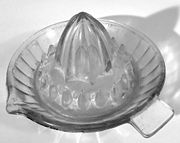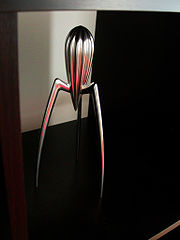
Lemon squeezer
Encyclopedia

Lemon
The lemon is both a small evergreen tree native to Asia, and the tree's ellipsoidal yellow fruit. The fruit is used for culinary and non-culinary purposes throughout the world – primarily for its juice, though the pulp and rind are also used, mainly in cooking and baking...
s or other citrus
Citrus
Citrus is a common term and genus of flowering plants in the rue family, Rutaceae. Citrus is believed to have originated in the part of Southeast Asia bordered by Northeastern India, Myanmar and the Yunnan province of China...
fruits such as oranges, grapefruit, or lime. It is designed to separate and crush the pulp of the fruit in a way that is easy to operate. Lemon squeezers can be made from any solid, acid-resistant material, such as plastic, glass, metal (usually aluminium
Aluminium
Aluminium or aluminum is a silvery white member of the boron group of chemical elements. It has the symbol Al, and its atomic number is 13. It is not soluble in water under normal circumstances....
) or ceramic.
History

Kütahya
Kütahya is a city in western Turkey with 212,444 inhabitants , lying on the Porsuk river, at 969 metres above sea level. It is the capital of Kütahya Province, inhabited by some 517 804 people...
, Turkey
Turkey
Turkey , known officially as the Republic of Turkey , is a Eurasian country located in Western Asia and in East Thrace in Southeastern Europe...
and date to the first quarter of the 18th century. These ceramic presses are in the traditional style of Turkish pottery of the 18th century and have a superficial resemblance to today's press equipment with cones, though they are designed differently. These examples were individually made, and specially designed for making the then popular citrus drink sorbet. Lemons are not native to northern Turkey, though during the 17th and 18th centuries they were imported in bulk to Constantinople
Constantinople
Constantinople was the capital of the Roman, Eastern Roman, Byzantine, Latin, and Ottoman Empires. Throughout most of the Middle Ages, Constantinople was Europe's largest and wealthiest city.-Names:...
.
At the end of the 19th century a large number of different models of lemon squeezers were patented in the United States. The U.S. Patent and Trademark Office
United States Patent and Trademark Office
The United States Patent and Trademark Office is an agency in the United States Department of Commerce that issues patents to inventors and businesses for their inventions, and trademark registration for product and intellectual property identification.The USPTO is based in Alexandria, Virginia,...
lists over 200 patents for lemon squeezers, the majority of which were registered between 1880 and 1910. The oldest of these patents was issued to Lewis P. Chichester on July 3, 1860 for a cast iron squeezer. The stated purpose of the invention was "to obtain a simple, economical and durable implement whereby lemons may be squeezed for domestic purposes with much less power and with far greater facility than by the ordinary squeezers in general use."
Functioning
The premise of the lemon squeezer is simple: Pressure is exerted on a lemon to force its juice and pulp from its rind; the juice and pulp often escape through a filterFilter (chemistry)
In chemistry and common usage, a filter is a device that is designed to physically block certain objects or substances while letting others through. Filters are often used to remove solid substances suspended in fluids, for example to remove air pollution, to make water drinkable, and to prepare...
or sieve
Sieve
A sieve, or sifter, separates wanted elements from unwanted material using a woven screen such as a mesh or net. However, in cooking, especially with flour, a sifter is used to aerate the substance, among other things. A strainer is a type of sieve typically used to separate a solid from a liquid...
. The squeezer itself must resist the pressure, so soft, easily deformable materials cannot be used. Because the lemon juice is very acidic, the squeezer can only be made of acid-resistant materials.
Among squeezers that employ a twisting central projection, both manual and electric options exist; for the manual squeezer the operator must turn the device and hold the lemon (or turn and hold the lemon) while the electric squeezer turns it automatically and the operator must simply hold onto the lemon. Other squeezers simply crush the lemon against a stationary central projection; these usually employ long handles, to gain the mechanical advantage
Mechanical advantage
Mechanical advantage is a measure of the force amplification achieved by using a tool, mechanical device or machine system. Ideally, the device preserves the input power and simply trades off forces against movement to obtain a desired amplification in the output force...
of a lever
Lever
In physics, a lever is a rigid object that is used with an appropriate fulcrum or pivot point to either multiply the mechanical force that can be applied to another object or resistance force , or multiply the distance and speed at which the opposite end of the rigid object travels.This leverage...
.
As a decorative object

Philippe Starck
Philippe Patrick Starck is a French product designer and probably the best known designer in the New Design style...
in 1990. It is considered an icon of industrial design
Industrial design
Industrial design is the use of a combination of applied art and applied science to improve the aesthetics, ergonomics, and usability of a product, but it may also be used to improve the product's marketability and production...
that has been displayed in New York's Museum of Modern Art
Museum of Modern Art
The Museum of Modern Art is an art museum in Midtown Manhattan in New York City, on 53rd Street, between Fifth and Sixth Avenues. It has been important in developing and collecting modernist art, and is often identified as the most influential museum of modern art in the world...
. It is manufactured by Italian kitchenware company Alessi. Its diameter is 14 cm, height 29 cm, and it is made from cast and polished aluminium
Aluminium
Aluminium or aluminum is a silvery white member of the boron group of chemical elements. It has the symbol Al, and its atomic number is 13. It is not soluble in water under normal circumstances....
. As the founder of the company Alberto Alessi recalls "I received a napkin from Starck, on it among some incomprehensible marks (tomato sauce, in all likelihood) there were some sketches. Sketches of squid. They started on the left, and as they worked their way over to the right, they took on the unmistakable shape of what was to become the juicy salif. While eating a dish of squid and squeezing a lemon over it, Starck drew on the napkin his famous lemon squeezer."
For the tenth anniversary of its launch, 10,000 were individually numbered and gold plated. There has also been a grey/black (Anthracite) coloured version of which 47,000 un-numbered examples were produced between 1991 and 2004. Both now are collectors items, though an "urban legend
Urban legend
An urban legend, urban myth, urban tale, or contemporary legend, is a form of modern folklore consisting of stories that may or may not have been believed by their tellers to be true...
" seemingly perpetuates that the anthracite version is rarer than the gold plated version.
The gold plated version was described as an ornament because the citric acid in a lemon discolors and erodes the gold plating. Starck even said his squeezer was, "not meant to squeeze lemons" but "to start conversations".
External links
- Image of the Juicy Salif at the Centre Georges PompidouCentre Georges PompidouCentre Georges Pompidou is a complex in the Beaubourg area of the 4th arrondissement of Paris, near Les Halles, rue Montorgueil and the Marais...
, ParisParisParis is the capital and largest city in France, situated on the river Seine, in northern France, at the heart of the Île-de-France region...

